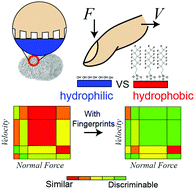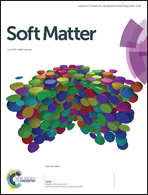Role of fingerprint-inspired relief structures in elastomeric slabs for detecting frictional differences arising from surface monolayers†
Abstract
The perception of fine texture of an object is influenced by its microscopic topography and surface chemistry—i.e., the topmost layer of atoms and molecules responsible for its surface energy, adhesion, and friction generated when probed by a fingertip. Recently, it has been shown that human subjects can discriminate high-energy (i.e., hydrophilic), oxidized silicon from low-energy (i.e., hydrophobic), fluorinated alkylsilane-coated silicon. The basis of discrimination was consistent with differences between stick-slip friction frequencies generated when sliding the fingertip across the two surfaces. One aspect that was not examined was the presence of surface relief structures on the fingertip. Indeed, papillary ridges—fingerprints—may be involved in enhanced discrimination of fine textures arising from surface roughness, but how (or whether) fingerprints may also be involved in the discrimination of surface chemistry—through its effect on friction—is unknown. Here, using a mock finger made from a slab of silicone rubber shows that relief structures amplify differences in stick-slip friction when slid across either a hydrophilic oxide or a hydrophobic monolayer on silicon. We quantify the similarity between the friction traces of the mock fingers sliding across hydrophilic and hydrophobic surfaces under varying velocities and applied masses using a cross-correlation analysis. We then convert the cross-correlational data into convenient “discriminability matrices.” These matrices identify combinations of downward forces and sliding velocities that enhance differences in friction between hydrophilic and hydrophobic monolayers. In addition, a computational model of macroscopic, “rate-and-state” friction confirms that frictional differences in chemistry are amplified when elastic slabs bear a patterned interface. This biomimetic approach to engineering sliding interfaces may inform the development of improved electronic skin and haptic devices and may contribute to understanding the role of relief structure in tactile perception.



 Please wait while we load your content...
Please wait while we load your content...